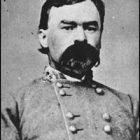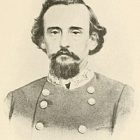Battle of Ebenezer Church
The Battle of Ebenezer Church was a battle that was fought near Plantersville, Alabama between Union Army cavalry under Brigadier General and Brevet Major General of volunteers James H. Wilson and Confederate States Army cavalry under Major General Nathan Bedford Forrest on April 1, 1865 during Wilson’s Raid into Alabama near the end of the American Civil War.
On April 1, 1865, Confederate Army Lieutenant General Nathan

Nathan Bedford Forrest
Bedford Forrest chose the area around Ebenezer Church in Stanton, Alabama to combat the approaching Union forces of Major General James H. Wilson. By the afternoon of April 1, Forrest had positioned an approximate force of 4,000 defenders, about half of which were veteran soldiers, east-to-west along the intersection of two small country roads near Ebenezer Church.

James H. Wilson
He hoped that the strong position would give his outnumbered force the chance to hold off Union attacks until 3,000 approaching reinforcements under Brigadier General William H. Jackson could cross the Cahaba River and hit the rear of Wilson’s army. At the same time, Forrest expected his main line to be reinforced by additional troops under General James R. Chalmers.

William Hicks Jackson
Both Chalmers and Jackson were delayed and Forrest wound up facing Wilson alone. After a fierce fight, the Confederate lines were broken and General Forrest and his men fell back to Selma.

James Ronald Chalmers
Forrest could not fend off the coming tide of Wilson’s troops and retreated back to Selma for the battle that would come the next day leading to the fall of Selma. This battle would become known as one of the most fierce battles of the Civil War.
Return to Alabama Civil War Index
Additional Resources:
Yankee Blitzkrieg: Wilson’s Raid through Alabama and Georgia
Wilsons Cavalry Corps: Union Campaigns in the Western Theatre, October 1864 Through Spring 1865
